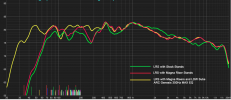Correct about stereophile measurements but absolutely wrong about mine.
The goal of these measurements is to find out how the speaker radiates sound independent of the room. That way, we find the true physical behavior of the speaker. Once there, we can then apply that to our own situations. The Klippel NFS and measurements in anechoic chamber both produce such data and it is absolutely essential in finding design issues in the speaker.
How a speaker behaves in a room is different and both dipole and regular monopole speakers are impacted by the room. That is why we have secondary measurements. Vertical directivity for LRS for example shows razor thin angle where you get anything close to a full range speaker. This was confirmed in my listening tests and no room can eliminate it.
The measurements also predicted how I heard the speaker. Bass was non-existent despite having a real floor contrary to what you stated. Indeed, measurements tell us the effect of the floor reflections just as well:
The blue line tells you the effect of the floor bounce. It provides some enhancement in low frequencies but there is so much of a deficit there that you are still left with a speaker that simply doesn't have any bass.
Predicted in-room response actually includes the effect of the above reflections and produced this:
This absolutely matched my in-person listening as indicated by the EQ making a massive difference in correcting the ills of this speaker. If you listened with EQ, you would want to run away when it was turned off! It compensated for both lack of bass and too little treble.
So no, the measurements are not at fault. The tell the truth and are a great tool in figuring out how to correct the response of this speaker if you wanted to go that way.
Another measurement of in-room response:
If you own or are interested in a pair of Magnepan LRS loudspeakers, the VPE Electrodynamics Little Dipole Woofer Model 1 and Magna Riser...

hometheaterhifi.com
It's still bass deficient, but doesn't show the decline below 300 Hz that your measurements do. I don't know anything about the size of the room or the measurements distance -- with open-baffle speakers in general, the larger the room, the larger the baffle required for good bass response, and you really want to listen to these in the near field if you can. As Magnepan's Wendell Diller put it, in a large room, the LRS sounds like a midrange.
The reviewer here also made a measurement mistake, which is that he measured and listened with the jumper in place. That isn't the default -- the 1 ohm resistor is -- the jumper is for bright rooms. I don't know why Magnepan doesn't make this clear, because everyone makes the same mistake. I don't know how you measured (forgive me if you said, it's been a year since I read your original review), but if you add the jumper, the graph above will look a bit more reasonable.
The HF issue can be addressed by tilting the speaker so that your ears are on axis vertically at your listening position. (The gentle decline is intentional -- it's a built-in house curve.)
That said, I continue to be interested in the fact that a speaker that doesn't measure well sounds so damn good. I heard it once, at AXPONA, and it was impressive, and I'm hardly alone in that judgement -- it's an almost universal response among critics and the general public. And I've heard that its successor, the LRS+, was the hit of this AXPONA -- it's basically the same thing with cleaner mids and highs. This, from the hometheaterhifi review, is typical:
"I quickly began to understand why Maggies have such a following. When set up right (with the tweeter portions to the outside in my case), the music just sounds effortless with massive and deep imaging. People have called them holographic sounding and I can certainly see how they would conclude that. Instruments and vocals also had a natural ease about them. Percussion details were especially quick and precise in their sound and very well resolved overall."
(He also goes on to mention some of the speaker's flaws: "Yet even at their best, in my room, the LRS had some obvious limitations in their bass abilities. Namely, the bass level, in general, was rather polite and what bass there was, dropped off like a stone below 70 Hz. There also was an occasional mild sense of brightness in the treble that I noted, but I wasn’t ready to mess with one of the padding resistors yet because I wanted to hear what, if anything, would happen when I switched to the Magna Riser stands." He missed one that others seem to miss -- if you really crank the levels, they fall apart.")
That's pretty close to my subjective impression as well, which I find interesting. The massive and deep imaging, well, that's the dipole reflections, as we've discussed. The other stuff, well, yes, but I find it harder to explain.
All of this in the context of a $750 speaker. I haven't heard anything that sounds this good on acoustical music in that price range. Clearly, there are better loudspeakers from Magnepan and others for more money. But to me, the wonder of the LRS is that it sounds so good at that price. (Even more so at the original $650, but they're backordered 5 months so it didn't make sense to keep the price that low.)



